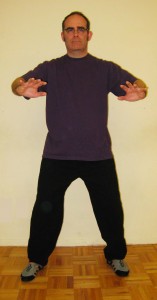In praise of standing (again)
 I’ve been off Zhan Zhuang (jam jong), or standing practice for a little while, being busy with school and work, but it’s time to get back into it. Returning to a practice after having been away usually gives me a new insight into it, though usually a small one. Sometimes I come back with some skill, effectively resetting the “beginner’s mind”, but usually I just return somewhat refreshed.
I’ve been off Zhan Zhuang (jam jong), or standing practice for a little while, being busy with school and work, but it’s time to get back into it. Returning to a practice after having been away usually gives me a new insight into it, though usually a small one. Sometimes I come back with some skill, effectively resetting the “beginner’s mind”, but usually I just return somewhat refreshed.
In the case of standing, I’ve had some time to think about what it has done for me in between standing sessions — you know, when I’m moving around like a normal person. At those times, I pay close attention to where my weight is, how I’m balanced, and I also notice little anomalies in my body sooner, leading me to avoid the habits that caused them. In general, standing has helped me get to know my body better, and not by learning anatomical vocabulary (useful though that may be for communicating about the body). No, standing has helped me find my balance, use my weight to act on things yet stay physically centered and find an optimal way of interacting with the forces of the real world.
Yes, stand in one spot for a while and see the world. An inner worlds, I guess. Stand long enough — properly — and you’ll begin to adjust your position and alignment until your weight is distributed by a greater and greater number of your muscles, tendons and bones. The more body parts that help out, the less work each one has to do. Now of course, there’s an optimization here: some parts are not involved. However … given that most standing postures involve the arms being held up, this allows you to engage body parts that would be limp if you didn’t have to hold your arms up.
So what? Well, I’ve found that not only is there a structural reason to involve a number of systems in standing, there’s an energetic reason too. Now I’m not going to get all “chi” on you, but I’ll just say that when I place a relaxed attention on part of my body, I get a pleasant tingle. When I can enlarge the area to which I’m attending, the tingle gets stronger. When the whole body is being attended to, the tingle is really something, and I feel like jumping up and running around the block. It’s quite something.
It’s hard, as I’ve written before, but I’m now remembering how good it felt when I did it regularly.
(Holy cow, was I ever off-center back then.)